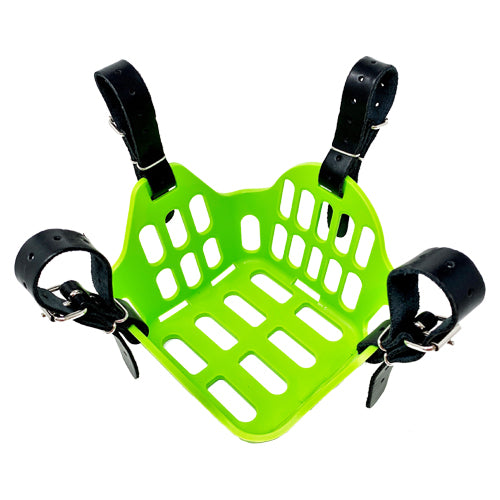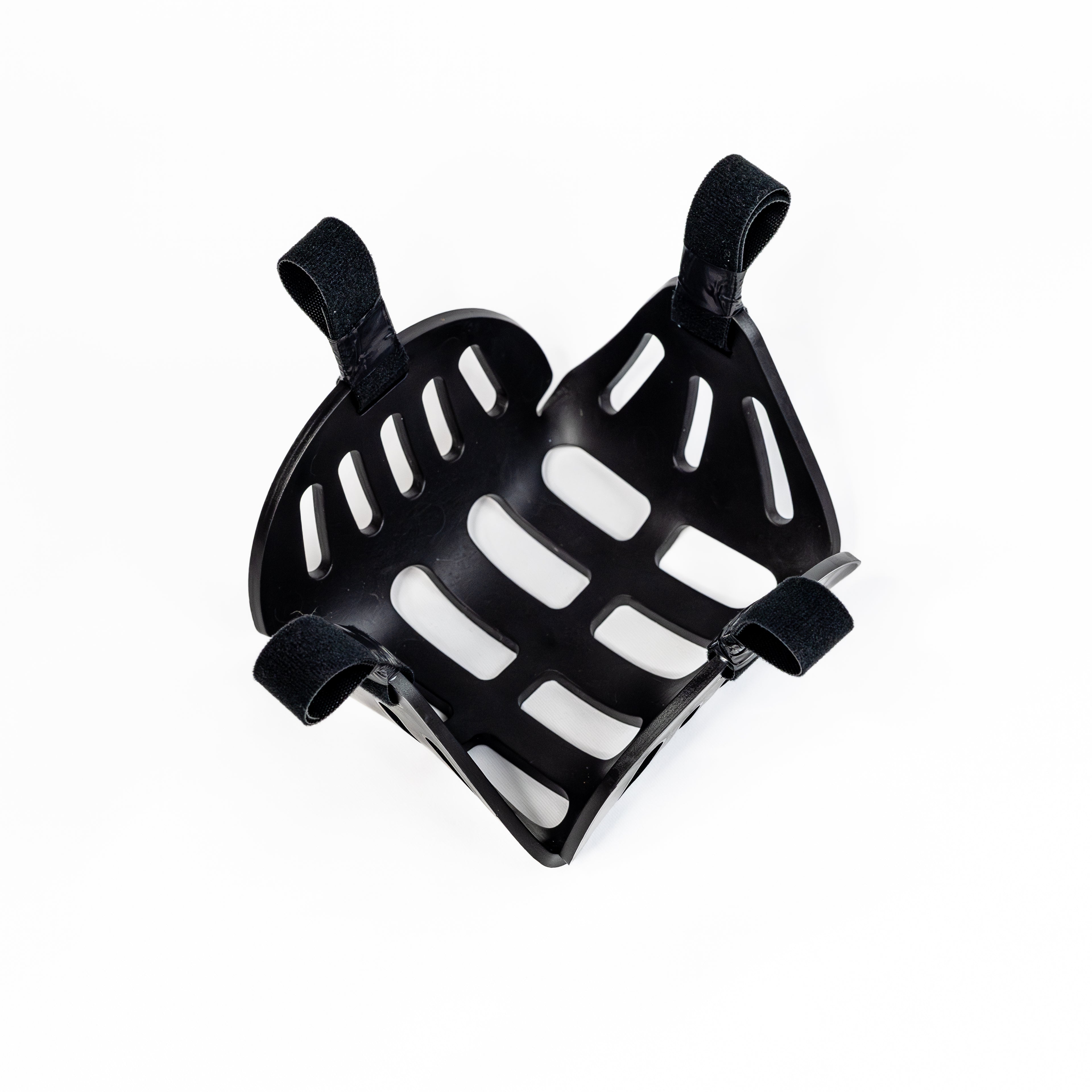Common Horse Grazing Muzzle Problems
Grazing muzzles are a handy way of helping your horse mimic natural grazing by acting as a slow feeder that your horse wears. But, there can be grazing muzzle problems that require adjustments to make your horse happy and comfortable.
Many horse owners are suspicious, wary, or scared of using grazing muzzles because of what they have heard about them. Let's review some insights into these rumors and what you can do about them.
Common Problems with Muzzles
Imagine it's the dead of summer. It's 95 degrees outside, and your horse has a heavy canvas muzzle on their face. Many muzzles cause rubs, which create hair loss and sores. There's so much fabric and material that they aren't comfortable, and there are not enough air vents.
Your horse may also be determined to eat all of the grass, and the muzzle shows how much wear and tear a horse's teeth can inflict while making a larger opening. Or, your horse has halter removal skills formerly unseen in the horse world.
Drinking can be tricky for some horses while wearing a muzzle, and we don't want to encourage dehydration, especially during extreme cold or heat. You can do many things to help your horse thrive while wearing a slow-feeding muzzle.

Raise your hand if you've got a "grazing muzzle graveyard" in your barn! Photo by Alanna on Instagram.
Rubbing and Chafing are Common Grazing Muzzle Problems
Traditional canvas or nylon muzzles are famous for rubbing chins and cheeks raw, often leaving painful, open sores. The typical shape of a round bucket is usually too narrow for comfort. With this narrow design, the canvas fabric constantly touches your horse's nose, causing irritation and chafing on the nose and/or chin while chewing.
Another reason for rubbing is things getting trapped inside the muzzle. Most muzzles create a tight enclosure around a horse's nose and mouth. Moisture, dirt, and debris can easily find their way inside. The longer they remain, the more likely they are to cause friction and irritation. The prolonged rubbing can lead to lacerations on the nose and chin and opportunities for infection, making for a pretty disgruntled horse.
The solution for rubs and sores
Proper grazing muzzle and halter fit is the key to eliminating chafing and discomfort while eating.
Adding padding to soften the feel against your horse's skin is tempting. Extra padding is an excellent solution for the halter's crownpiece, as there is little friction in that area. Padding may tighten the contact in other places, making friction more intense.
Choosing a muzzle design that provides ample room around the muzzle is the first step. Structured designs with baskets allow your horse to move within that space without rubbing their faces. You may also need to step up a size to allow more room.
Make any contact points slippery
Some contact points will always be between the muzzle, halter, and horse. The cause of rubs is friction, and reducing friction diminishes the likelihood of rubs. The easiest way to do this is with a fly mask. Technical fabrics like lycra create a smooth barrier under halters and the tops of muzzles, making friction disappear.
A properly fitted halter will not allow anything to slide off their head, no matter how Houdini-esque they are. A properly fitted halter and muzzle give your horse all the benefits of grazing without the discomfort that encourages them to disrobe.
Read this article about properly fitting a muzzle to your horse.
Traditional grazing muzzles fit too tightly around the horse's nose and mouth. Photo by Chelle129 on Shutterstock.
Dirt and Other Irritants
Dirt, grit, and debris are not the only things that tend to remain inside many grazing muzzles. Moisture caused by rain or sweat cannot dry or evaporate naturally inside nylon, canvas, or similar cloth materials that make up most traditional grazing muzzles. Heat and moisture create the ideal conditions for bacteria and mold to grow, thrive, and reproduce.
Add poor ventilation, and suddenly, you've got a horse that must deal with a muzzle that may injure them while they're trying to graze, and encouraging secondary infections simultaneously.
You can rinse and clean your horse's muzzle daily. If you see patterns in wear or dirt collection, this is a sign to make fitting adjustments to keep your horse more comfortable. You may need to go up a size, too.
Airflow, Breathing, and Heat
Muzzle ventilation is a common concern among those with easy-keepers, especially in the hotter months. When looking at the design of most grazing muzzles, you will notice they wrap very near to the nostrils.
This claustrophobic setting alone can cause the horses to have a lot of breathing issues. Reduced ventilation and airflow are significant concerns, especially in horses with heaves (Recurrent Airway Obstruction) or other chronic conditions like allergies that make breathing difficult.
Durability
There is a common theme among some grazing muzzle styles: the openings increase in size through wear. This expansion increases the volume of grass consumed and leads to frequent replacement, creating more significant expenses.
Scotchy the horse chewed a gigantic hole in this grazing muzzle, making it practically useless. Photo by Mariah on Twitter.
Houdini Horses and Ponies Escaping the Grazing Muzzle
Some horses feel trapped and confined because traditional muzzles are not well-ventilated. Horses are naturally very playful, as well as intelligent. They are brilliant at teaching other horses how to assist in their escaping adventures. Helpful herd mates sometimes play with their friend's halters or muzzles and help take them off.
Reba the Morgan was at least kind enough not to leave her grazing muzzle out in the pasture! Photo by Jessie on Instagram.
Horses will do anything to feel comfortable, breathe easily, and return to munching on grass. Is your horse a Houdini? If your answer is yes, you are far from being alone.
Some horses can rub the crownpiece of their halter on a board to slip it over their ears. Others can pull it down over their nose, and you will find it in their mouth or around their neck. Rolling on the ground is also very common. Rolling allows them to rub their head on the ground and force the contraption over their ears.
Your solution is to use a halter that stays put. Clever, adjustable throat latches allow for comfortable tightening while maintaining breathability and preventing the halter from going around the cheeks. Well-ventilated designs with many openings also give your horse the sensation of touching and eating more grass, even if they are not.
Muzzles that Reduce Grass Intake and Solve Problems
The makers of GreenGuard muzzles noticed all these common behaviors. They designed a grazing muzzle for horses, ponies, and donkeys that considers all these factors.
How does the use of a grazing muzzle by GG-Equine improve upon standard or traditional basket muzzles?
- Rubbing: Due to the square shape of the GreenGuard muzzle, we don't see the rubbing that is so prevalent with traditional nylon muzzles. The muzzle doesn't lie on their face, which can attract moisture and debris. This limits or eliminates friction when the muzzle moves around their nose. It is very open around the sides, allowing the horses to feel the grass within reach. This tricks them into thinking they are getting more grass than they are.
- Debris and drainage: The open basket design means horses can eat and drink without worrying about trapped water or increased heat. The holes are large enough to allow water and debris to move through the muzzle basket.
- Airflow: The muzzle basket is spacious enough to keep plenty of air flowing, which does not mean they are eating more. Eating out of only one or two slots at a time means that, depending on the horse and the pasture conditions, a GreenGuard muzzle reduces grass intake by 30%-70%, equal to or better than other muzzles on the market. A small hole in other designs is not always best.
GreenGuard muzzles are designed to address all of the most common issues!
- Durability: This is where the GreenGuard really shines. Our grazing muzzles use a poly-resin material that is sturdier and lightweight. Many of our users have gone from needing a new muzzle every season, to being on their third, fourth, or even fifth consecutive seasons with a GreenGuard. GreenGuard is the only muzzle company that offers a one-year, one-time replacement warranty for our muzzles in case of breakage or wear. These muzzles are made in Germany and have been tried, tested, and trusted in Europe for over 20 years.
- Anti-Houdini: The muzzle and halter are highly adjustable, ensuring a good, comfortable fit for your horse. We are also masters at troubleshooting. If you're having any problems, get in touch with us! For the strongest or cleverest Houdinis, we suggest a neck strap that attaches through the top of the halter crown piece and buckles behind the throat latch.
Grazing muzzles: they look weird, but they're necessary!
There's a common (and incorrect) assumption that grazing muzzles are cruel. They are a simple device that helps keep a horse at a healthy weight, reduces the likelihood of laminitis and colic, and gives many horses proper turnout for long periods. It's more cruel to allow your horse to become overweight, develop metabolic disorders like equine metabolic syndrome (EMS) and insulin resistance, get gas colic, or founder.
Not all muzzles are created equal! Finding the best muzzle and halter design will help your horse stay happy and avoid health issues, especially those linked to weight gain.
Can horses still drink with a grazing muzzle?
Of course, if their water source is wide enough to accommodate the basket. Many larger buckets, muck tubs, and troughs are ideal for muzzle-wearers. If you use a narrower waterer, check this chart to compare your muzzle to many of the industry's automatic waterer devices.



















































